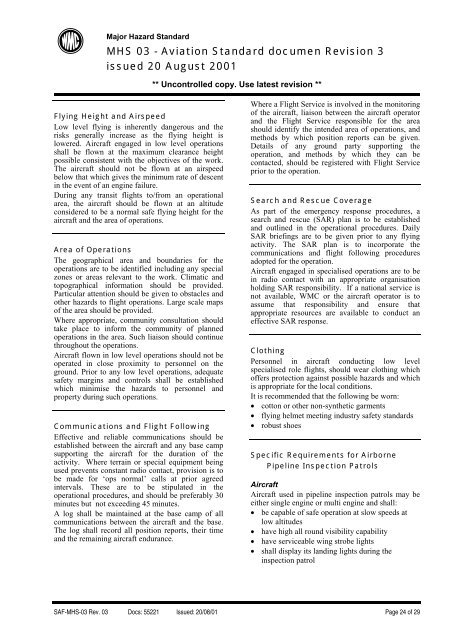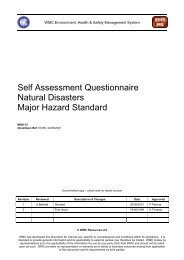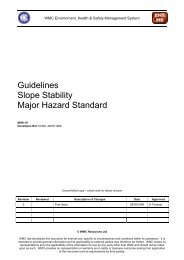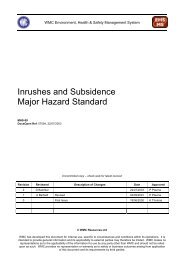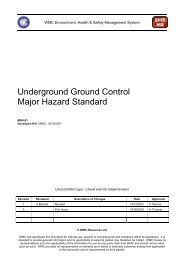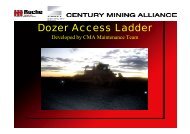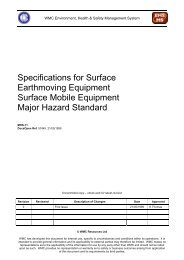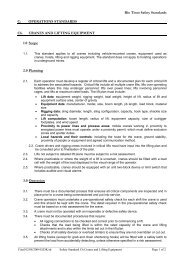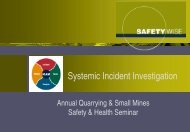Aviation Major Hazard Standard - MIRMgate
Aviation Major Hazard Standard - MIRMgate
Aviation Major Hazard Standard - MIRMgate
Create successful ePaper yourself
Turn your PDF publications into a flip-book with our unique Google optimized e-Paper software.
<strong>Major</strong> <strong>Hazard</strong> <strong>Standard</strong><br />
MHS 03 - <strong>Aviation</strong> <strong>Standard</strong> documen Revision 3<br />
issued 20 August 2001<br />
** Uncontrolled copy. Use latest revision **<br />
Flying Height and Airspeed<br />
Low level flying is inherently dangerous and the<br />
risks generally increase as the flying height is<br />
lowered. Aircraft engaged in low level operations<br />
shall be flown at the maximum clearance height<br />
possible consistent with the objectives of the work.<br />
The aircraft should not be flown at an airspeed<br />
below that which gives the minimum rate of descent<br />
in the event of an engine failure.<br />
During any transit flights to/from an operational<br />
area, the aircraft should be flown at an altitude<br />
considered to be a normal safe flying height for the<br />
aircraft and the area of operations.<br />
Area of Operations<br />
The geographical area and boundaries for the<br />
operations are to be identified including any special<br />
zones or areas relevant to the work. Climatic and<br />
topographical information should be provided.<br />
Particular attention should be given to obstacles and<br />
other hazards to flight operations. Large scale maps<br />
of the area should be provided.<br />
Where appropriate, community consultation should<br />
take place to inform the community of planned<br />
operations in the area. Such liaison should continue<br />
throughout the operations.<br />
Aircraft flown in low level operations should not be<br />
operated in close proximity to personnel on the<br />
ground. Prior to any low level operations, adequate<br />
safety margins and controls shall be established<br />
which minimise the hazards to personnel and<br />
property during such operations.<br />
Communications and Flight Following<br />
Effective and reliable communications should be<br />
established between the aircraft and any base camp<br />
supporting the aircraft for the duration of the<br />
activity. Where terrain or special equipment being<br />
used prevents constant radio contact, provision is to<br />
be made for ‘ops normal’ calls at prior agreed<br />
intervals. These are to be stipulated in the<br />
operational procedures, and should be preferably 30<br />
minutes but not exceeding 45 minutes.<br />
A log shall be maintained at the base camp of all<br />
communications between the aircraft and the base.<br />
The log shall record all position reports, their time<br />
and the remaining aircraft endurance.<br />
Where a Flight Service is involved in the monitoring<br />
of the aircraft, liaison between the aircraft operator<br />
and the Flight Service responsible for the area<br />
should identify the intended area of operations, and<br />
methods by which position reports can be given.<br />
Details of any ground party supporting the<br />
operation, and methods by which they can be<br />
contacted, should be registered with Flight Service<br />
prior to the operation.<br />
Search and Rescue Coverage<br />
As part of the emergency response procedures, a<br />
search and rescue (SAR) plan is to be established<br />
and outlined in the operational procedures. Daily<br />
SAR briefings are to be given prior to any flying<br />
activity. The SAR plan is to incorporate the<br />
communications and flight following procedures<br />
adopted for the operation.<br />
Aircraft engaged in specialised operations are to be<br />
in radio contact with an appropriate organisation<br />
holding SAR responsibility. If a national service is<br />
not available, WMC or the aircraft operator is to<br />
assume that responsibility and ensure that<br />
appropriate resources are available to conduct an<br />
effective SAR response.<br />
Clothing<br />
Personnel in aircraft conducting low level<br />
specialised role flights, should wear clothing which<br />
offers protection against possible hazards and which<br />
is appropriate for the local conditions.<br />
It is recommended that the following be worn:<br />
• cotton or other non-synthetic garments<br />
• flying helmet meeting industry safety standards<br />
• robust shoes<br />
Specific Requirements for Airborne<br />
Pipeline Inspection Patrols<br />
Aircraft<br />
Aircraft used in pipeline inspection patrols may be<br />
either single engine or multi engine and shall:<br />
• be capable of safe operation at slow speeds at<br />
low altitudes<br />
• have high all round visibility capability<br />
• have serviceable wing strobe lights<br />
• shall display its landing lights during the<br />
inspection patrol<br />
SAF-MHS-03 Rev. 03 Docs: 55221 Issued: 20/08/01 Page 24 of 29


